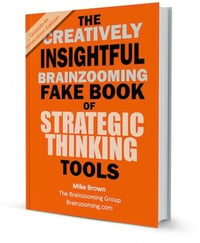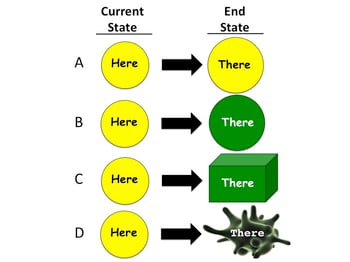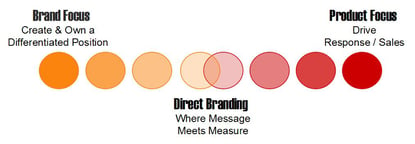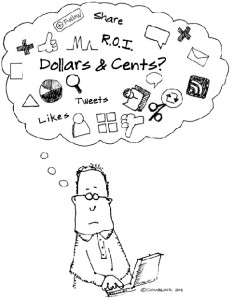It's the first post of 2015 from customer experience strategy and innovation expert Woody Bendle. Today, Woody takes on performance metrics and a strategic look at how the measures you use with dramatically new and different strategies need to also be dramatically new and different themselves. Here's Woody!
Performance Metrics - What Gets Measured? by Woody Bendle
 We’ve all heard the axiom, “What gets measured gets _________.”
We’ve all heard the axiom, “What gets measured gets _________.”
You can fill in the blank: done, fixed, improved, managed.
The point is if you want to accomplish (fix, improve, manage) something, you need to:
- Have some idea about the desired outcome you’re seeking (vision or objective)
- Establish an identifiable target – or series of targets (goals)
- Do things that help you move toward the goals and desired outcome (activities and processes)
- Have ways to determine if you are making progress toward achieving your identifiable target(s) and/or desired outcome (measures)
If you’ve spent any time in the business world, you know there is certainly no lack of performance metrics (or measures) for determining how a business or unit is performing and whether or not you are making progress toward your desired goals or objectives.
Most of these performance metrics – or “Key Performance Indicators,” aka KPI - are tried and true and have been around for decades. And, many businesses have achieved success by adopting standard measures and employing well-known programs, processes and procedures for collecting, reporting, and monitoring activities and progress.
The more familiar or standard your desired outcome (or end state), the easier it is to be successful by employing standard activities, processes and measures. But if your desired end state is very different from your current state, it is highly unlikely that standard activities, processes, and measures will suffice. If you want to be very different, you need to do things very differently and you probably also need very different measures (or metrics) to get you there.
To help make my point, let’s take a look at these four illustrative “current state / end state” scenarios.
The current state, represented by the yellow “Here” circle, is identical for scenarios A through D but the end state varies in how different it is from the original yellow circle.
Scenario A is understandable for many in business. The end state here is basically the same as we currently are, but bigger. In the business world this might be analogous to growing by selling more of our existing products to existing customers or to new customers in new territories.
Scenario B also isn’t much of a stretch. The end state remains a circle, gets a little bigger, and becomes a little more different by doing something different (i.e., adding blue) to turn the circle green. In business, this may be growing by adding a new product line and selling more to new and existing customers.
Scenario C is clearly a different end state. The end state is bigger, changed color, completely changed shape, and added a new dimension. The business analogy might be a combination of Scenario B as well as an acquisition of a business either up or downstream in the value chain and/or possibly even another totally unrelated business.
For Scenarios A-C, there are thousands of real world examples (or business cases) managers can leverage for how an organization can get from here to there. These suggest the types of things you need to do, and what the types of measures you need to employ in order to monitor and ensure your progress.
For Scenario D, however, all bets are off.
In Scenario D the desired end-state is frankly something that bears no resemblance to the current state. Think Apple Computers in the 1980s vs. the Apple we know today. Scenario D’s end state looks pretty unique, complex, hard to describe and quite possibly, very difficult to duplicate. Scenario D is actually illustrative of the types of conversations occurring at many companies today with business model innovation or business transformation.
To achieve the transformative end state in Scenario D, you will likely have to do many things very very differently. And, you will also likely need to create and utilize completely different measures or performance metrics to help get you there.
So yes, what gets measured gets done, fixed, improved, managed, and possibly changed. But allow me to modify the oft mis-attributed Einstein quote on insanity:
“If you are expecting to achieve radical transformational results by employing (or tweaking) existing processes, procedures, measures or metrics, you’re completely nuts!
If your desire is to transform your business or organization, do yourself, your shareholders and your entire organization a favor. Clearly envision, define and articulate:
- Where / what you want to be
- All the possible paths you might take to get there
- How long it might take to arrive at different points along the path
- What you need to do to know if you are making progress, and if you are nearing your desired end state
If you are having a hard time getting started with this, I’m betting Mike and the folks of The Brainzooming Group have well over 100 articles that can help you out! - Woody Bendle
If you enjoyed this article, subscribe to the free Brainzooming blog email updates.
Download: FREE Innovation Strategic Thinking Fake Book
 Are you making the best use of customer input and market insights to deliver innovation and growth? Creating successful, innovative new products and services has never been more dependent on tapping perspectives from outside your organization.
Are you making the best use of customer input and market insights to deliver innovation and growth? Creating successful, innovative new products and services has never been more dependent on tapping perspectives from outside your organization.
This new ebook features sixteen strategic thinking exercises to help you ideate, prioritize, and develop your best innovative growth ideas. Download this free, concise ebook to:
- Identify your organization’s innovation profile
- Learn and rapidly deploy effective strategic thinking exercises to spur innovation
- Incorporate crowd sourced perspectives into your innovation strategy in smart ways





